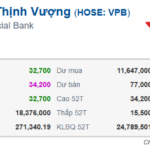
Author: Mr. Nguyen Hoang Linh – Director of Investment Portfolio Management, Vietcombank Securities Investment Fund Management Company Limited (VCBF)
|
The integration of AI into IR practices offers unprecedented advantages in real-time market data analysis, investor interest forecasting, personalized communication, and information disclosure process automation. Whereas IR teams previously spent hours or even days compiling data and writing reports, many of these tasks can now be completed in just a few minutes.
In developed markets, numerous businesses have integrated AI into their IR platforms in the form of predictive analytics, helping to determine the optimal time for information dissemination and tailor content to investors’ interests. For instance, two companies listed on the New York Stock Exchange (NYSE), Skechers USA and Ciena, have utilized AI to analyze historical data and anticipate analysts’ questions during periodic earnings calls. This enables leadership to prepare thorough and timely responses while minimizing the risk of overlooking critical information. [1]
According to Broadridge, a financial infrastructure provider, several listed companies in developed markets also leverage AI to analyze shareholder behavior, classify investors, and personalize IR messages for different target groups. [2] Some companies have integrated AI chatbots on their IR websites to provide instant answers to frequently asked questions and collect feedback to refine their communication strategies. These applications have significantly reduced response times, enhanced information consistency, and improved the investor experience.
In recent years, many Vietnamese enterprises have also swiftly adopted AI to optimize their operations, including customer service automation, data analysis, demand forecasting, and personalized experiences. A survey by CPA Australia revealed that 74% of businesses in Vietnam have implemented digital strategies, including AI, surpassing the Asia-Pacific regional average of 63%. Among these businesses, 98% reported significant improvements in operational efficiency and customer experience. From the user perspective, a Microsoft survey found that 88% of knowledge workers in Vietnam have used generative AI in their work, higher than the global average of 75%.
However, the in-depth application of AI in IR activities has not yet been widely adopted by many organizations. This delay can be attributed to a lack of technology-savvy personnel, high initial investment costs, and, most notably, concerns among managers about the difficulty of controlling the quality of AI-generated content in automated interactions with investors, which could lead to the risk of conveying inaccurate or inappropriate information.
Challenges and Solutions
While the opportunities are vast, integrating AI into IR practices presents several challenges. Firstly, data quality is essential, as AI is only as good as the data it is trained on. Inaccurate or incomplete data can lead to erroneous analysis, negatively impacting the company’s reputation.
Secondly, allowing AI to handle sensitive financial and business strategy data in IR activities raises concerns about information leakage or misuse. Additionally, an important human factor to consider is that IR involves not just data transmission but also building trust and emotional connections with investors. Over-automating these processes may cause businesses to lose personal “touchpoints,” which are vital in fostering long-term relationships with shareholders.
As a member of the judging panel for the IR Awards 2025, VCBF observes that most listed companies in Vietnam are still at the basic stage of digitalization. For instance, they conduct IR by publishing reports online, using data management software, or adopting online meeting services. The strategic utilization of AI, such as predicting investor behavior or optimizing information disclosure timing, remains limited.
To truly unlock the value of AI in IR activities, VCBF suggests a three-step roadmap for businesses. Firstly, data standardization and cleansing are crucial to ensure that all financial information, reports, and investor feedback are consistently stored and easily accessible. Secondly, combining AI with the IR team’s experience is essential, as AI excels in numerical analysis and trend recognition, but human expertise is still needed for communication strategies and handling complex situations.
Lastly, IR departments must maintain transparency and accountability, even when employing new technologies. All information disclosed to the market should comply with legal requirements and be accurate and verifiable. In conclusion, while AI will not replace humans in IR, it can be a powerful ally when used judiciously. A business that strikes a balance between technology and human elements will not only enhance its market communication effectiveness but also strengthen investor trust, thereby laying a solid foundation for sustainable growth.
Nguyen Hoang Linh – Director of Investment Portfolio Management, VCBF
[1] Wall Street Journal
[2] broadridge.com
Unlocking Innovation: Propelling Data Exploitation as the Epicenter of Economic Prosperity
On August 18th, at the Hoa Lac High-Tech Park in Hanoi, a momentous occasion took place with the attendance of Pham Minh Chinh, a member of the Politburo and the Prime Minister of Vietnam. The event marked the official launch of the National Data Center No.1 and the inauguration of the National Database System hosted within the center. This significant development in Vietnam’s technological landscape was organized by the Ministry of Public Security.
The Textile Industry’s Workforce Restructuring: Navigating Automation and Labor Shortages
The future of work in the textile industry is undergoing a significant transformation. With automation, green transition, and shifting demographics as key drivers, businesses are rethinking their human resources strategies. The focus now shifts to reskilling and retaining employees, as forecasts predict a significant 22% of global jobs will be impacted in the 2025-2030 period.
The Great Challenge for Vietnamese Businesses: Embracing Automation and AI in Manufacturing
“Even seemingly minor issues, such as loose, broken, or rusted bolts and screws, can significantly impact the customer experience. Businesses may spend tens of millions of dollars annually on component replacement and repairs.”









































